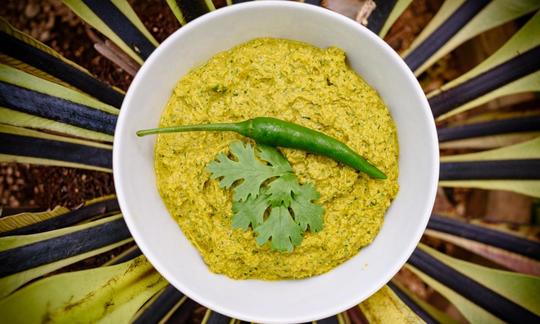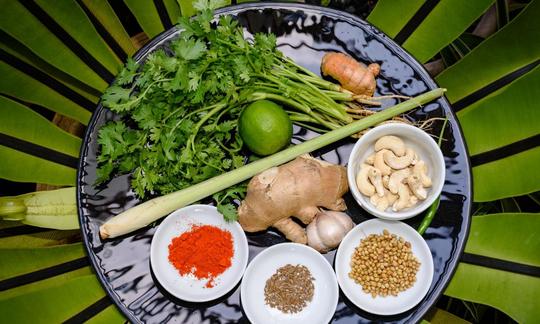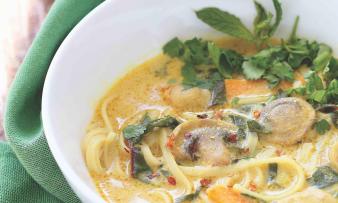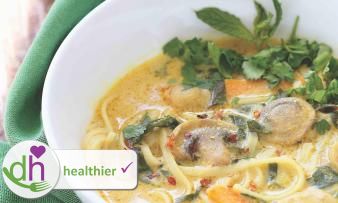Adapted from a recipe by Richa Hingle , Laksa curry paste with fresh turmeric and ginger is also suitable for dishes that require red curry paste.
Use in the kitchen:
This Laksa paste is used as a base for making Laksa curry soup. You can also use the aromatic paste in any recipe that requires a red curry paste. The curry paste gives the dishes a pleasantly spicy flavor with many different aromas.
| Not only vegans or vegetarians should read this: Vegans often eat unhealthily. Avoidable nutritional errors. |
Purchasing - where to buy?
Laksa curry paste is also available ready-made in vacuum packs or screw-top jars. You can find the paste in selected Asian shops or on the Internet. The ingredients may differ from those listed here. Some Laksa pastes (Penang Laksa or Assam Laksa) contain dried shrimps, skimmed milk powder and palm oil. Like most ready meals, many ready-made Laksa curry pastes contain preservatives, acidifiers and thickeners such as sodium benzoate (E 211), citric acid (E 330), silicon dioxide (E 551) or starch esters (E 1414). Since they may also contain flavour enhancers such as monosodium glutamate (E 621), please read the list of ingredients very carefully. Here are two articles about experiences with flavour enhancers: Experiences with company canteens and Glutamate experience with spice mixes in your own kitchen.
Recipe for making your own:
Making your own Laksa curry paste is definitely better in terms of taste and health than buying it. You'll see that when you read the two links above. Preparation only takes a few minutes.
To prepare this vegan laksa curry paste, soak the cashews or almonds in warm water for about 15 minutes. Roast the coriander seeds and cumin seeds in a hot pan for 2-3 minutes until aromatic. Then grind these spices in a small blender. Now add the turmeric, ginger, chili pepper, cayenne pepper, lemongrass, garlic, soaked and drained cashews, coriander and lime juice to the blender and puree until a smooth paste is formed. If necessary, you can add about 1 tablespoon of water so that the ingredients combine better to form a paste. You can find the exact recipe here.
For an original Laksa, you use candelnuts, also known as Indian walnuts, instead of cashews. In this recipe, we have replaced the Laksa leaves, which are responsible for the characteristic taste, with lots of coriander, which gives the Laksa paste a greenish color. In the original, the paste is red, due to dried shrimps and both fresh and dried red chili. In addition to the ingredients listed, galangal is also used.
For a nut-free version, you can use pumpkin seeds instead of cashews.
If you don't have fresh turmeric, you can replace it with the ground version. For the appropriate replacement, add about 1 teaspoon of the ground powder to about 20 grams of fresh turmeric. However, the dried form has a significantly different taste.
You can try your own variations of your Laksa curry paste, swap ingredients or add new ones. For garnishing a Laksa curry soup, you can use crispy fried shallots, eggplant, tofu, mushrooms or cucumber strips sprinkled with ginger, dried pineapple, various roasted nuts, fresh sprouts or herbs, etc. 1
Storage:
The paste will last for one week in an airtight container in the refrigerator, or up to one month when frozen.
General information:
Laksa is a Southeast Asian soup from Indonesia, Malaysia, Singapore and southern Thailand. In Singapore it is considered a national dish, in Malaysia it is a dish of 1000 ingredients. Laksa soup is prepared using coconut milk and chili (also called curry laksa) or sour asam (tamarind, gelugur = Garcinia atroviridis or kokum = Garcinia indica) 2.5 and fish stock. A combination of the two options also exists. The soup usually also contains rice or ribbon noodles. There are numerous variants such as Katong Laksa (Singaporean), Bogor Laksa (Indonesian) or Penang Laksa (also called asam laksa, clear broth, Malaysian), although the basic ingredients and pastes differ. 3,4 Coconut milk laksas are curry laksas (e.g. Katong or Bogor Laksa), laksas made from tamarind and fish stock are traditionally called Asam Laksas (e.g. Penang Laksa). 5
Where the word "laksa" comes from is not clear. In ancient Indian, "lakshas" means something like "one hundred thousand" and probably refers to the many ingredients that could be used for laksa.
Literature / Sources:
- Unileverfoodsolutions.ch Laksa.
- Wikipedia English Laksa.
- Wikipedia Laksa.
- asiancorrespondent.com/2012/10/laksa-discovering-malaysias-signature-dish/
- wikiwand.com/en/Laksa












Comments